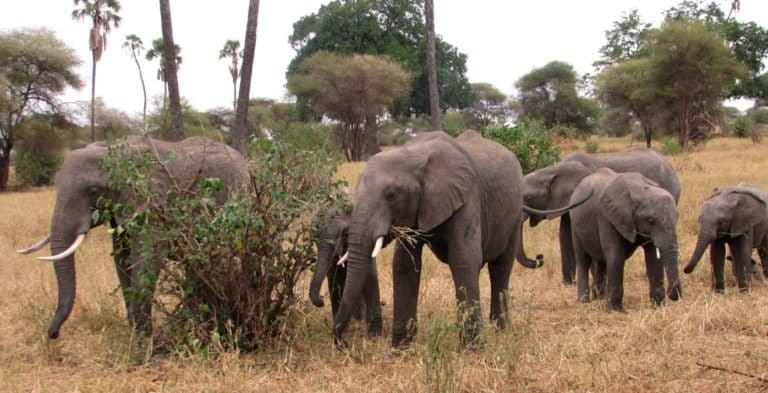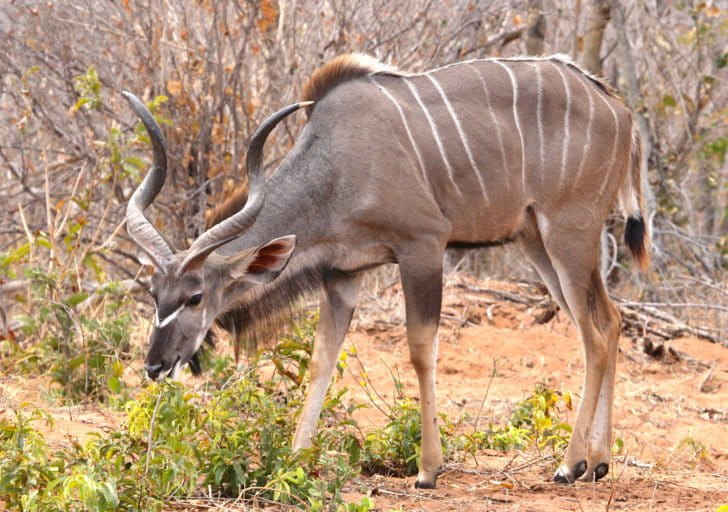- DNA barcoding—the collection, extraction, sequencing, and translation of a species’ DNA into a digital barcode—is being used to combat poaching and illegal wildlife trade.
- Investigators compare wildlife barcodes of evidence at crime scenes or confiscated animal products to the known barcode sequences of the suspected species.
- The Barcode of Wildlife Project fosters collaboration among partner countries to build a global reference library that connects the work of researchers across the globe on a single platform and allows for a species’ barcode to be a public resource for biodiversity conservation, invasive species monitoring, and wildlife crime mitigation.
It is a trade that is worth more than $15 billion a year in the global market and threatens some of the world’s most iconic species. The illegal trade in wildlife overwhelms national capacities and international efforts to staunch its flow, while raking in profits for traders of rhino horn, elephant ivory, tiger bones, and a host of other poached and illegally-traded wildlife parts. Despite the presence of internationally-recognized institutional mechanisms that aim to recognize and protect threatened species, like the Convention on International Trade in Endangered Species (CITES), efforts to mitigate wildlife crime are, at present, beyond control.
Within national borders, law enforcement and investigators attempting to crack down on the illegal trade face the common challenge of simply determining cases of wildlife crime. Identifying animal parts from a crime scene or from confiscated animal products can be a difficult process that raises critical questions: once a specimen containing DNA evidence has been obtained for a suspected case of wildlife crime, how can scientists link the DNA to a particular species? And, once a match has been confirmed, how can investigators verify whether the sample marks a case of poaching or illegal trade?

It turns out that in identifying species from DNA samples, the answers lie within a specific gene that can be detected and matched against a DNA sequence from a known species. For animals, this gene, known as cytochrome c oxidase 1, or CO1, can be compared not only across individuals within one species, but also across different species.
Officials investigating a case need a complete sample of a species’ DNA that contains the CO1 gene and is secure and free from contamination. To verify the species of a sample’s CO1 gene, they also need solid reference samples against which the gene can be compared. Yet without public access to such samples, it can be nearly impossible for investigators to match the sample to a species and to confirm whether the species has been illegally obtained or traded.
This is where the Barcode of Wildlife Project (BWP) steps in. The project is an ambitious global initiative of the Consortium for the Barcode of Life (CBOL), which was awarded a $3 million Global Impact Award by Google to apply a process known as DNA barcoding to combatting wildlife crime. In DNA barcoding, lab work identifies and sequences a specific section of a sample’s DNA and creates a unique barcode for each species. The BWP team uploads these barcodes onto a secure and publicly-accessible reference database. As more and more species’ barcodes are collected, the value of the barcodes as tools for species identification grows.

The BWP fosters collaboration between partner countries to encourage research biologists, investigators, criminal prosecutors, and members of law enforcement to use DNA barcodes to help identify wildlife samples and to upload barcodes for use on a variety of conservation issues by individuals and organizations all over the world. Currently, the Project is conducted across three partner countries – Kenya, Mexico, and South Africa – where scientists and law enforcers from select organizations work to identify species and investigate suspected cases of wildlife crime that may lead to the prosecution of suspected poachers and illegal wildlife traffickers.
The research teams carefully monitor the DNA barcoding process – from initial DNA sampling, extraction, and sequencing, on to the final barcoding step – through a series of data checks, laboratory analyses, and approvals.
According to Dr. Monica Mwale, a research scientist with the National Zoological Gardens (NZG) of South Africa, the first step is to choose species that are listed as threatened or endangered under CITES and are frequent targets for the illegal wildlife trade. Once the species are chosen, researchers involved in the barcoding process must also consider ‘look-alike species’ – species that are either physically or genetically similar to the target species.
“For example, let’s say, you have lion, cheetah, leopard. Then you’ve got look-alikes, so we have things like the serval, like the common domestic cat, and look-alikes for all other big cats,” she explains. “We try and collect individuals from different geographic areas, so not specifically from the same place, because we want our reference sample to be geographically representative and also to represent the species.”
Scientists and investigators follow a strict chain of custody protocol to ensure that forensic samples are identified, collected, and sealed securely to prevent tampering or contamination. To confirm solid DNA references for the library, the BWP teams collect samples from five specimens for each species. They send the samples to a biobank, where they are accessioned into a collection, and then prep the samples for DNA extraction and analysis.

“You take a tissue sample [from which] you want to break the cells to get your DNA,” Mwale explains. “And then the polymerase chain reaction [PCR] amplifies the specific strand of DNA using primers and it multiplies that into a million different fragments so you can read the sequence. After you do the PCR and you amplify the specific fragment, you sequence that so that you can read what that sequence is for that specific gene or truncated fragment you’re working with. All animals have mitochondrial DNA. They’ve got specific genes that are specific to their taxon groups, but the mitochondrial genome is similar. The genes you get are the same for all species, and then the cytochrome c oxidase 1 gene is the one that’s being used for DNA barcoding. We run them on the genetic analyzer and get the specific nucleotide sequence for each species.”
Researchers use software to verify and upload the data into GenBank, a secure and publicly-accessible reference database that houses the Barcode of Wildlife Project’s collection of barcodes.

The collection aids investigations of poaching and illegal trade, once samples can be compared to the barcode sequence for a given species. Priority species’ barcodes, designated as such for their conservation status, as well as those of their look-alikes, are especially useful.
“In South Africa, the major issue we have with wildlife crime is poaching,” Mwale notes. “You have a couple antelope species that are the most common ones: there’s kudu — always, always, always, kudu — impala, and blesbok, warthog, gemsbok, waterbuck, bushbuck — those are the most common poaching cases we get. Then you get these high-profile species — we get a lot of elephant. We get ivory or we get blood samples. We also get lion — it’s becoming much more. We get a lot of lion cases recently. We are getting pangolin cases. So, we get live, confiscated pangolins; scales; or dead pangolins.”

Pangolins are reported to be the most highly-trafficked mammalian species in the global illegal wildlife trade. Valued for their scales, which are used for traditional medicine in China and Vietnam, and for their meat, they are currently listed in CITES under Appendix I, designating that the species is considered threatened by extinction.
So far, Mwale’s team has worked with roughly 86 cases of wildlife crime.
“We had a case where there were two suspects, who we found illegally hunting oribi, and then we did a species ID. They’re not supposed to hunt oribi without a license. They were fined sixty-thousand rand [ZAR]; each was supposed to pay thirty-thousand rand [ZAR]. They were given two years’ suspended sentence.”
But not every case is easy to win. A frequent challenge for BWP scientists is working with the substandard quality of some forensics exhibits, which, if poorly secured, risk the contamination of samples. Another complication is that the process of investigation involves many components, each of which must be successful in order for a suspect to be prosecuted.
“In some of the cases we’ve done where we’ve had very good results in the lab, the person goes free because then they don’t have the data from the human side,” says Dr. Mwale. “They can’t link the person to the crime scene. They can’t link him to the event, so he walks scot-free because they can’t link his DNA to the crime scene. We can always I.D. the animals — we know it’s this CITES-listed species, but then if the person cannot be linked to the crime scene…”
It is difficult work for researchers and investigators, alike. The process can be tedious and slow, and obtaining all of the reference material needed from five high-quality specimens of each species can be especially challenging. According to Mwale, most of the animals, particularly large mammals like elephants, must be immobilized by a veterinarian. Some of the smaller species can be very hard to find.

Andrea Jiménez-Marín, a Mexican partner who manages the Molecular Systematics Zoology Lab at the UNAM Biology Institute (IBUNAM), also faces challenges in procuring samples in the field.
“The samples are very difficult to obtain because there’s [substantial] endemicity in this country, and they are in a small place in Mexico in a specific season of the year,” Jiménez-Marín explains. “So we have very big troubles [in obtaining] these samples…Another problem is the researchers that work with that species sometimes don’t want to collaborate with us.”
She added that extracting viable DNA from very old samples found in certain collections is challenging, as their DNA is often degraded.

Nevertheless, Jiménez-Marín’s team has nearly completed their efforts to barcode every species of spider – all tarantulas – on the priority species list. They have also barcoded many bird species, including, with difficulty, the harpy eagle.
“Here in Mexico…There is only one in a zoo, in a live collection, and there are two in the United States,” notes Jiménez-Marín. “We have sampled the only live harpy in Mexico, and we expect to obtain the other two samples that are in the U.S.”
The collaborative nature of the BWP is key in building a global reference library that connects the work of researchers across the globe on a single platform and allows for a species’ barcode to be a public resource for biodiversity conservation, invasive species monitoring, and wildlife crime mitigation.
Combining the rapidly expanding BWP DNA reference library with a global database of nationally-designated protected species and corresponding legal regulations on hunting, trade, and transport would be a significant step in international wildlife crime mitigation. For now, the BWP will continue to help fight for species protection through sustained, collaborative efforts – one sample at a time.